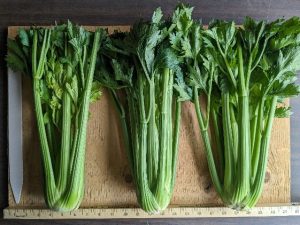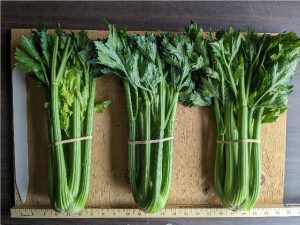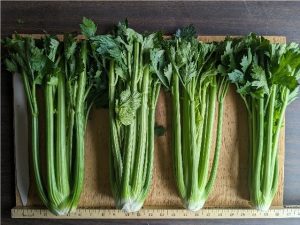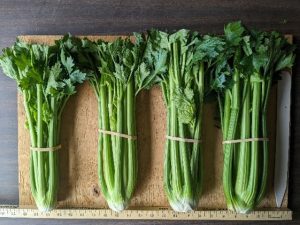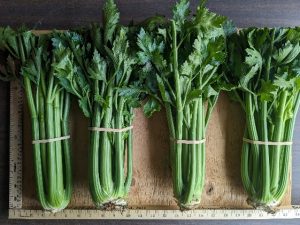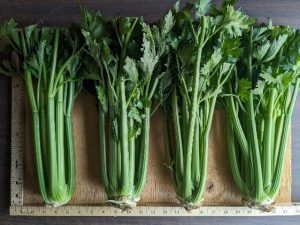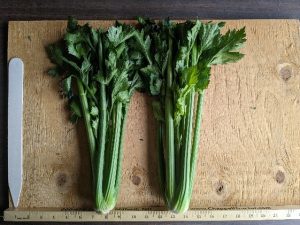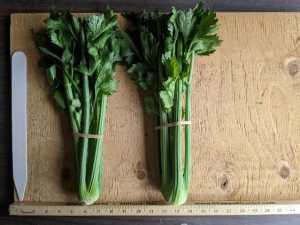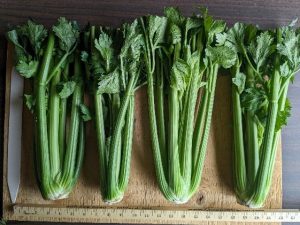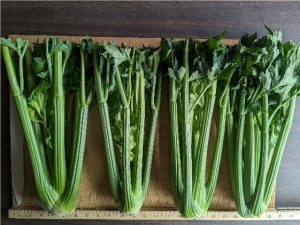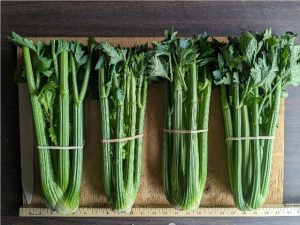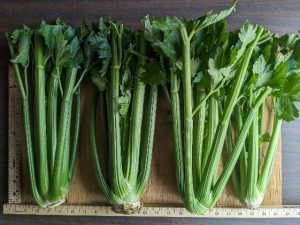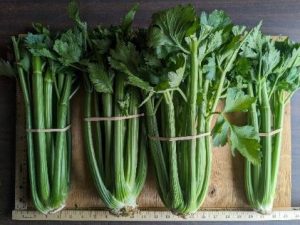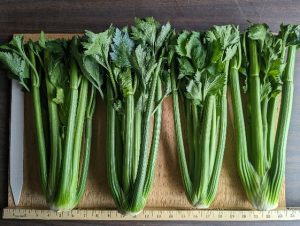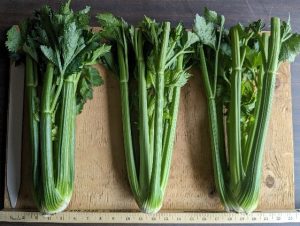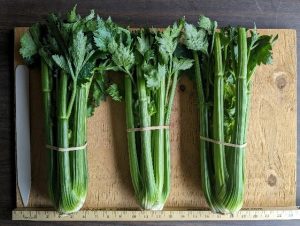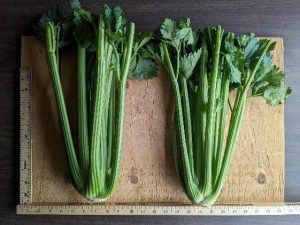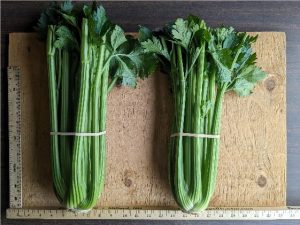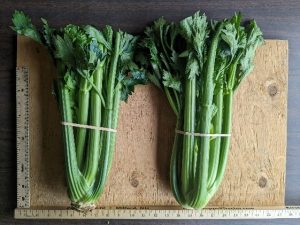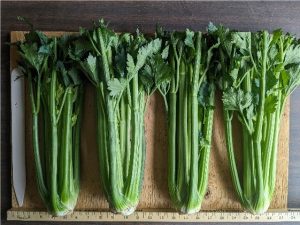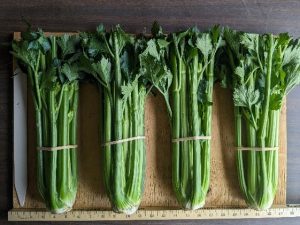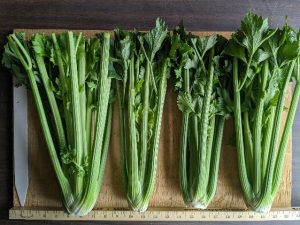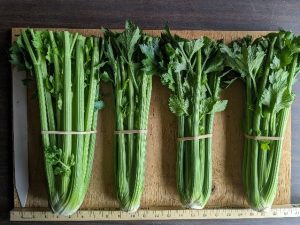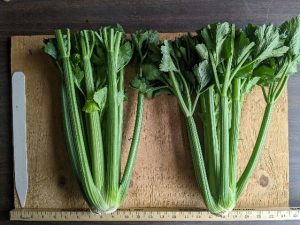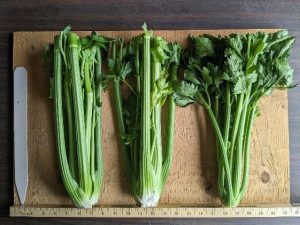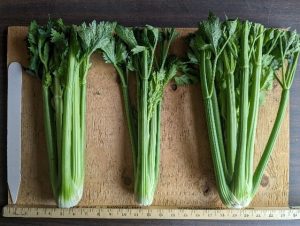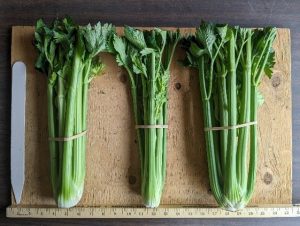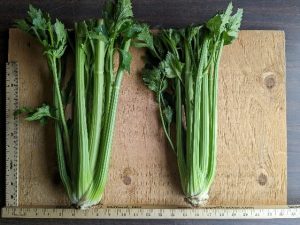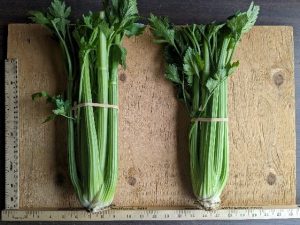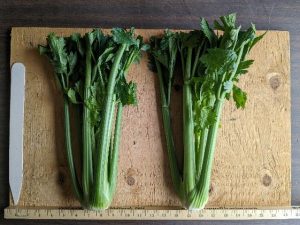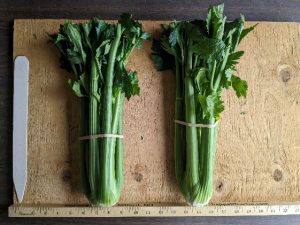Celery Evaluations: 2023 Research Report
Peyton Ginakes, University of Maine Cooperative Extension Research Associate
Mark Hutton, University of Maine Cooperative Extension Vegetable Specialist
David Handley, University of Maine Cooperative Extension Small Fruit & Vegetable Specialist
The third year of a celery trial was conducted at University of Maine’s Highmoor Farm in 2023. The purpose of the evaluations was to continue developing celery cultivar and management recommendations for Maine farmers, and to enhance the quality and production of Maine-grown celery. Eighteen celery cultivars were compared for their agronomic, horticultural, and storage potential. Separately, a mulch trial was conducted to compare the effect of three different plastic mulches on celery production.
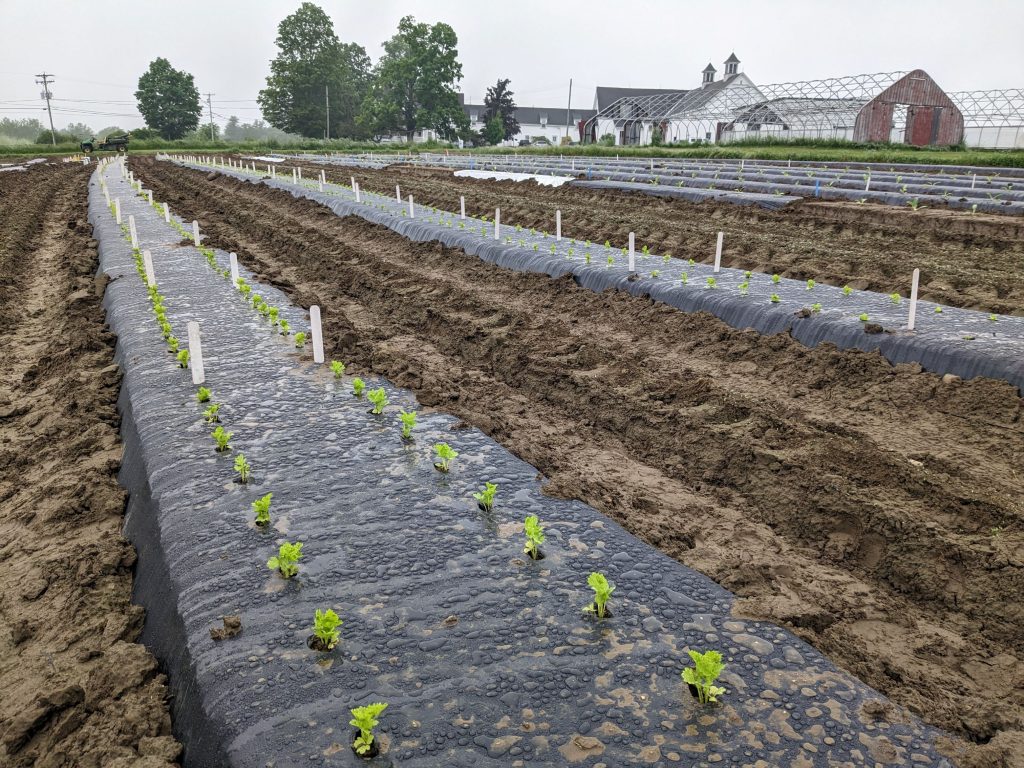
Seedling Production
Celery was seeded into 128-cell trays filled with ProMix BX + Mycorrhizae media on April 18 and placed on 70 ˚F heating mats in the greenhouse. Seedlings were fertilized with 1 Tbsp/gal of Jack’s Professional 12-45-10 Plant Starter soluble fertilizer on May 12. Trays were taken off heating mats one month later, May 18, and thinned to one seedling per cell.
Mulch Trial
Similar to 2022, three mulches were evaluated for their effect on celery production: 1) black plastic, 2) white on black biodegradable plastic, and 3) reflective mulch. Mulches are major aids in celery production where weed pressure can be prohibitive, as it is a slow-growing crop. Additionally, mulches may prevent soil nutrients from leaching from the crop root zone over the long growing season. We hypothesized that growing celery on white and reflective plastic mulches would produce greater yields compared to black plastic, primarily due to their soil temperature mediating effects.
The field was fertilized with 500 lb/ac of 10-10-10 before mulches were laid on raised beds. Mulches were arranged in a randomized complete block design with four replications. Plot dimensions matched those of the 2022 celery mulch trial, at 5.3 feet long, with 14 plants in double rows using an 8” in-row spacing with 14” between rows. Due to heavy rain, celery seedlings (cv. Merengo) were transplanted by hand on June 14 (57 days after seeding) with the aid of a rolling dibbler (Two Bad Cats, VT). Plants were watered in with 1 cup of the same soluble fertilizer solution immediately after transplanting. Plots were not irrigated due to excessive rain. Weeds between beds were controlled through a combination of hand weeding, hoeing, and flame weeding (Pyroweeder, Farmer’s Friend, TN). Captan and Asana® XL were applied at label rates on July 11 (27 days after transplanting) to suppress fungal pathogens and tarnished plant bug populations.
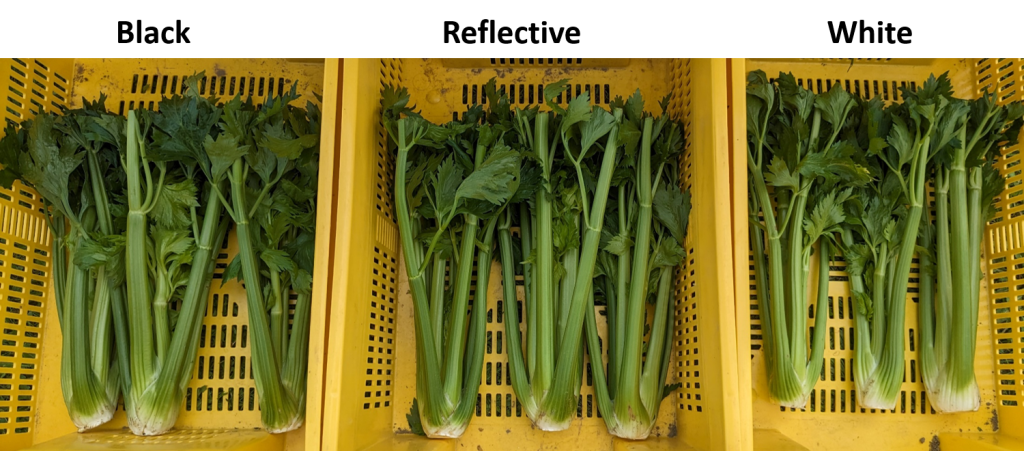
Four plants from each plot were harvested on September 21 (99 days after transplanting). Whole plants were weighed, and then outer petioles were removed until plants were in marketable condition and weighed again. Last, plants were topped to 14” and weighed for a final time. Ultimately, while plants grown on black plastic tended to be slightly smaller in size than those grown on reflective mulch or white on black plastic, mulch did not significantly influence plant size (Table 1).
a Plants trimmed to 14” in length and tops discarded.
Yield Evaluations
Eighteen celery cultivars were grown in a randomized complete block design field trial with four replicates. Plots were the same size and used the same spacing and cultural management practices as the mulch trial, and black plastic-mulched raised beds were used in all plots to reflect standard practice. Seedlings were transplanted June 13, 56 days after seeding.
Four plants from each plot were harvested on two dates: September 14 (93 days after transplanting) and September 28 (107 days after transplanting). Untrimmed, trimmed, and topped yield data were collected in the same fashion as in the mulch trial. Data were analyzed using harvest date as a main plot factor and cultivar as a subplot factor (Table 2).
Yield varied by both harvest date and cultivar (Table 2). Plant weight was larger at the second harvest regardless of whether plants were trimmed or topped. Untrimmed Kelvin, Goodwin, and TZ 6200 plants were all larger than Command, while the remaining 14 cultivars produced intermediately sized plants.
After trimming to marketable condition, Kelvin and Goodwin were significantly larger than Balada, Command, Sabroso, Titus, and Victoria (Table 2). Of these low-weight cultivars, all but Sabroso required trimming away about 30% or more of the plant to achieve marketable condition. In contrast, Bachata, Goodwin, Hudson, Kelvin, Sabroso, and Stalker required a significantly smaller proportion of trimming, typically 20% or less. Trimming plants can be time-consuming due to the decision-making required. Planting cultivars that require only minimal trimming can result in both larger bunches and labor savings.
Topping celery bunches is common for retail and wholesale markets. Ideally, this removes most of the lower-density, leafy tops and primarily the bulky petioles remain. Goodwin, Kelvin, and Stalker all produced tall, stocky plants with high nodes, and therefore the largest topped bunches (Table 2). Balada, Command, and Victoria had the smallest topped plant weights, as the trimmed plants were small and short to begin with. A larger portion of plants were removed by topping in Kelvin and Titus, tall cultivars, than Command, Frevo, and Merengo plants, which are generally short.
a Plants trimmed to 14” in length and tops discarded.
b Values in a column followed by the same letter are not different (p < 0.05).
Visual Quality Evaluations
Trimmed and topped plants from both harvests were retained after collecting yield data for quality evaluations the following day. Cultivars were visually rated for color, smoothness, pithiness, stringiness, and bolting. All characteristics were ranked on a 1-5 scale except for bolting, which was recorded as a proportion of plants with any seed stem elongation (Table 3).
a Color ranked on 1-5 scale; 1 = blanched, 5 = dark green; b Smoothness ranked on 1-5 scale; 1 = heavily ribbed 5 = barely detectable ribbing; c Pithiness ranked on 1-5 scale; 1 = hollow interior, 5 = no pithiness; d Stringiness ranked on 1-5 scale; 1 = many strings and no clean snap, 5 = no strings and clean snap; e Bolting is ranked as the proportion of four plants with any seed stem elongation; f Values in a column that are followed by the same letter are not different (p < 0.05); g Bold values indicate cultivars that differ significantly between harvests for a given quality (p < 0.05); h Shown only when interaction effect is not significant (p < 0.05).
Celery color was ranked with 1 being a blanched appearance, and 5 being a medium-dark green. All 18 cultivars evaluated fell between 2.5 and 3.6 over both harvest dates (Table 3). An apple green to bright green color is currently favored by most consumers, which this range reflects. Cultivar color differed only in the second harvest, where Command and Huron were a darker green than Frevo, Goodwin, Hadrian, Kelvin, Rivalry, and Sabroso. Balada, Command, and Huron were darker green at the second harvest than the first, while the opposite was true for Kelvin.
Petiole smoothness was ranked with 1 being heavily ribbed and 5 having barely detectable ribbing. Victoria was the most heavily ribbed cultivar at the first harvest, significantly more so than Frevo, Hadrian, Hudson, and Huron (Table 3). By the second harvest, Balada, Hudson, Huron, Merengo, and TZ 6200 were smoother than Bachata, Goodwin, Sabroso, and Stalker. Ribbing increased between the harvests in Goodwin and Stalker, but decreased in Balada and Titus.
Petiole pithiness was ranked with 1 being hollow, 3 having some pithiness but no breakdown, and 5 having no pithiness. We consider a pithiness rating of 3 to be the minimum marketable standard. Pithiness increases as plants mature, and was more severe in the second harvest as expected (Table 3). All cultivars averaged a rating of at least 3, but Sabroso and TZ 6200 were pithier than Hudson and Huron.
Stringiness was ranked by snapping petioles in half widthwise, with 1 denoting many strings without a clean snap, and 5 snapping cleanly with no trailing strings. Like pithiness, this is generally expected to increase as plants grow past their prime in the field. Stringiness did increase between harvests in Frevo, Goodwin, and Rivalry, but actually decreased in Hadrian and Hudson (Table 3). In the first harvest, Goodwin, Merengo, and Stalker were less stringy than Bachata and Command. In the second harvest, Huron, Kelvin and Stalker were less stringy than Bachata, Balada, Command, Frevo, Goodwin, Rivalry, TZ 6200, and Victoria. Overall, stringiness ranged from 2.3 to 3.9 across all cultivars and none was significantly different from one another.
Bolting in celery occurs with low temperature exposure. When plants are only beginning to bolt, they may remain marketable but will likely need more trimming as petioles crack at the base from seed stem growth. As the seed stem grows, however, bunches may become unmarketable. This can often be allayed by simply harvesting earlier. Bolting was not consistently impacted in this trial year by harvest date (Table 3). However, no Rivalry or Balada plants bolted compared to two-thirds of bolted Huron and Sabroso plants. The remainder of the cultivars evaluated were intermediate or variable.
Storage Trial
A subset of plants from each plot and harvest was set aside from the cultivar trial to evaluate storage life. Plants were individually weighed, packed into waxed boxes, and placed in a 34 ˚F cooler. At two and four weeks after harvest, plants were weighed to measure bunch weight decrease due to water loss. Then, petioles that had visibly deteriorated in quality were removed until the bunch was again considered marketable, and the plants were re-weighed to measure bunch weight decrease due to quality loss.
a Bold values indicate a significant difference between harvests (p < 0.05).
b Values in a column that are followed by the same letter are not different (p < 0.05).
Plants continue to respire after harvest, which leads to water loss. For ten of the 18 cultivars evaluated, bunches from the first harvest lost less water weight after four weeks of cold storage than those harvested two weeks later. Cultivar had a significant effect on proportion of water loss from second harvest bunches, where Huron and TZ 6200 lost upward of 35% of their original weight due to water loss alone, significantly more than Fandango and Rivalry, which lost less than 15% of their original weight (Table 4).
Quality decline, due to petiole yellowing as well as some soft rot, generally contributed to a greater share of bunch weight reduction in storage than water loss. Bunch weight loss due to quality was nearly 1.5x greater for plants harvested second than those harvested two weeks earlier. In total, after four weeks in storage, plants from the first harvest had reduced in size by 29%, significantly less than plants from the second harvest which were 57% smaller than when they had been put in storage.
Cultivars
| Bachata | |
|
|
|
| Balada | |
|
|
|
| Command | |
|
|
|
| Fandango | |
|
|
|
| Frevo | |
|
|
|
| Goodwin | |
|
|
|
| Hadrian | |
|
|
|
| Hudson | |
|
|
|
| Huron | |
|
|
|
| Kelvin | |
|
|
|
| Merengo | |
|
|
|
| Rivalry | |
|
|
|
| Sabroso | |
|
|
|
| Stalker | |
|
|
|
| Titus | |
|
|
|
| TZ 6200 | |
|
|
|
| Victoria | |
|
|
|
| Waltz | |
|
|
|
Acknowledgements
This work was funded in part by the USDA-NIFA Specialty Crop Block Grant program as administered by the Maine Department of Agriculture, Conservation, and Forestry, and additionally supported by the University of Maine Agricultural and Forestry Experiment Station, the Maine Vegetable and Small Fruit Growers Association, and Hatch ME022320. Bejo Seeds, Rispens Seeds, Seedway, and Tozer Seeds generously donated materials for this project. We are grateful for assistance from Chris Howard, Greg Koller, Patricia McManus, and Stephanie Wright, and field assistants Chantal Cyr, June Foyt, and Ethan Handley.
Please contact Peyton Ginakes at peyton.ginakes@maine.edu or (207)933-2100 with any questions or comments about this research.
© 2023
Download and Print:
Information on this website is provided purely for educational purposes. No responsibility is assumed for any problems associated with the use of products or services mentioned in this website. No endorsement of products or companies is intended, nor is criticism of unnamed products or companies implied.
In complying with the letter and spirit of applicable laws and pursuing its own goals of diversity, the University of Maine System does not discriminate on the grounds of race, color, religion, sex, sexual orientation, transgender status, gender, gender identity or expression, ethnicity, national origin, citizenship status, familial status, ancestry, age, disability physical or mental, genetic information, or veterans or military status in employment, education, and all other programs and activities. The University provides reasonable accommodations to qualified individuals with disabilities upon request. The following person has been designated to handle inquiries regarding non-discrimination policies: Director of Equal Opportunity, 5713 Chadbourne Hall, Room 412, University of Maine, Orono, ME 04469-5713, 207.581.1226, TTY 711 (Maine Relay System).

